Now that we have a view of these archetypes and their characteristics, let’s project ourselves onto the dynamics we could support. In most cases people question themselves when their company is dysfunctional. We’ve discussed two types of solutions for a dysfunctional company: a revitalization, when it’s about not changing its nature (its mission, its identity, its convictions), but becoming functional again; A reform, a change of nature, when it’s about rethinking oneself.
For this, the Dilts pyramid offers a good reading framework. As always, its use gives direction, it won’t be valid all the time. We’ll say that you are functional if your mission (your purpose), your identity, your convictions, your capacity (the means you give yourself), your behaviors and finally the environment that this generates are aligned. Otherwise you have dissonance. Your company is probably dysfunctional at one or more levels. If it concerns the more operational levels (capacity, behaviors, environment) you could “simply” revitalize yourself. If it concerns levels more linked to your essence (purpose, identity, convictions) it may be an indicator of a need for change of nature.
Don’t forget a change of nature logically occurs in the life cycle according to a known path. But if it’s about changing branches (so to speak) we need an external force (crisis, external actors, etc.).
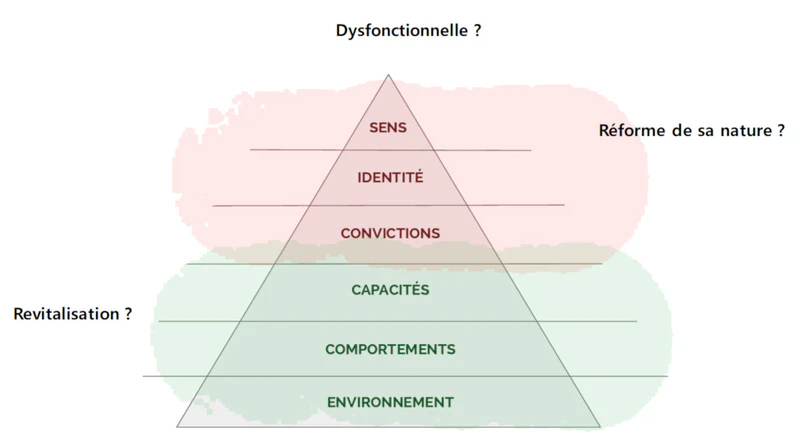
Here are some examples.
beNext Example
beNext very much resembles a company with the adhoc archetype from my point of view. An entrepreneurial culture that constantly adapts by aggregating skills. Reputation, and thus our search for excellence or no bullshit (two of our values), are very important. We make more classic functions coexist (HR, sales team), with less classic teams created dynamically by an assembly of skills (event offering, school of product ownership offering, robinsons offering (the famous agile “framing”), value driven enterprise offering, etc.). We manage by skills (again search for excellence), and the company brand like the personal brand are key, we want to develop them, also for our clients (our leitmotiv is be your potential internal as external).
Path
So I can think that beNext is a complex company with an adhoc type archetype. The structure is moreover led by David and myself, to form for some time a triumvirate with Dragos. The rest, as indicated by the typical structure of the adhoc archetype, is very flat.
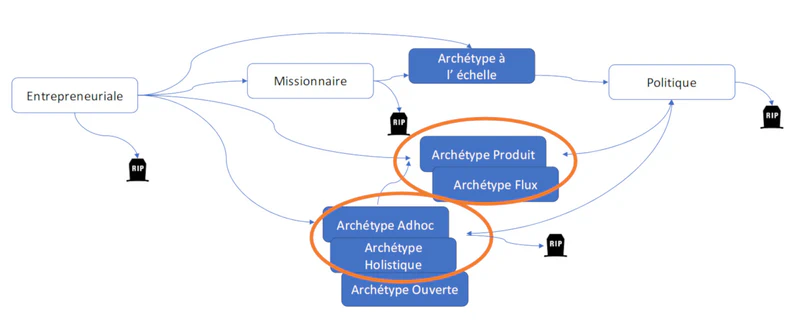
Today I wouldn’t say that beNext is a dysfunctional company (on the contrary). We’re reaching 130 people, and we’re heading towards 250 in the coming years. We could change nature. This expansion is a kind of attraction. We could become a product archetype. Teams by skills, in lab mode, could find a market in a more definitive way, and switch to product archetype tactics. It’s the skill of the product that would become more important than that of the person in a way. Another option, we could also to allow this growth make this managerial triumvirate disappear, by switching to a holistic archetype. It would be about completely empowering each group, for better resilience.
Example Problem: How to Rethink One’s Leadership to Go Further?
But today beNext is not dysfunctional and nothing obliges us to think about reforming. We can nevertheless anticipate dysfunctional aspects.
I told you about our problem around leadership here (already with the Dilts pyramid). The triumvirate could become a blocking element with a larger size. Do we have the capacity to have enough leadership? If this becomes dysfunctional, often the answer is found on the floor above in the pyramid that serves as our reading framework: it’s our convictions that must be worked on to no longer have dissonance on capacity (not enough leadership, too centralized strategy). The revitalization would go through convictions: we should perhaps rethink, align, our way of imagining leadership and its emergence (knowing that generally for a company in the adhoc archetype reputation is important for individual stakes).
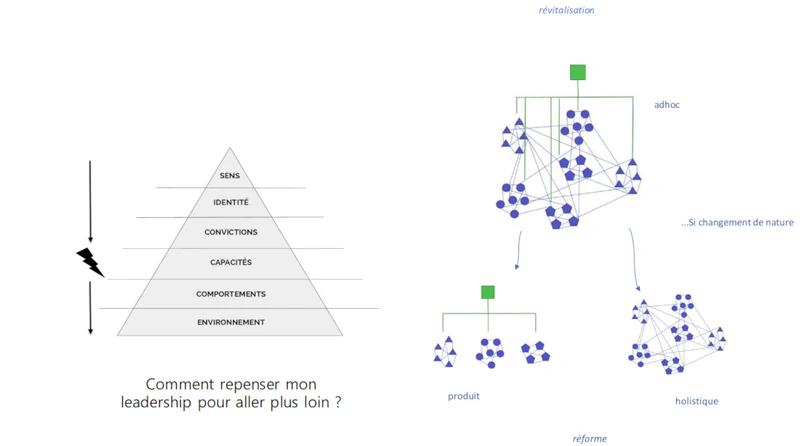
A Large Bank
A large bank, you all know them. We could say that it’s the archetype of the company at scale which is very mechanistic. A multiplication, quite mechanical, of the production apparatus, hence their attraction to frameworks like SAFe. It’s about mechanizing a production apparatus, not being product or flow focused, nor even less spontaneously creative by basing oneself on skills. This is neither bad nor good. We just need to approach the conversation this way in our view, and not believe that a mechanistic approach, company at scale, will bring product market type responses, or an ability to evolve in flow mode, for example.
The size of organizations that turn to the company at scale also allows us to say that probably they will divide into departments that won’t have the same archetypes. You know the large structure with the company at scale archetype, and its department, its incubator, with its adhoc archetype. Be careful, you’ll need to understand and anticipate the upheaval when two such different cultures and archetypes try to coexist.
Path
We can imagine a revitalization path that consists of instilling this company at scale archetype with new ways of working more adapted to this complex world. We can also imagine a search for reform of their nature to reposition themselves as a major product or flow actor (product, flow archetypes) (“being the best at their product” for example, with a real market logic, OKRs). Even a complete reform that proposes to reinvent themselves (adhoc archetype). This changes the strategic and tactical approach.
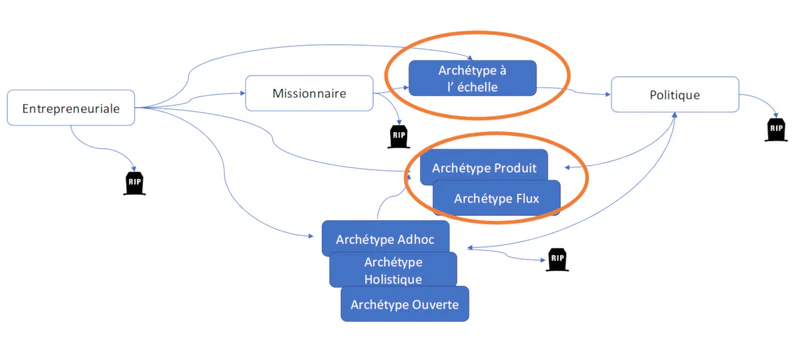
Example Problem: Act in Accordance with My Convictions or Truly Reform Myself?
The quintessential problem of these large banks, they refute their nature, their company at scale archetype, and its mechanistic approach. In this complex world where everyone calls themselves agile they want to be in the movement. On the Dilts pyramid reading, we could say that they give themselves the capacity (by hiring lots of “agile coaches”), that they impose new behaviors (retrospective, visual management, etc.), but neither their identities, nor their convictions, nor their purpose have changed. This causes strong dissonance. The dysfunctionality of these actors comes from there. The best would be for them to acknowledge their nature and not try to make agile from end to end an archetype that is rather mechanistic, it would probably work much better. Or if really the company at scale archetype no longer suits them, that the risk is too great, they should truly reform themselves, not only on the operational part (capacity, behaviors, environment), but right at the heart of who they are (purpose, identity, convictions).
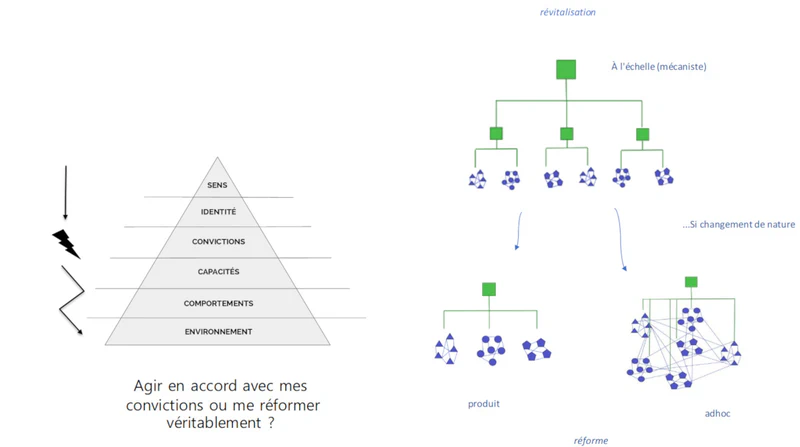
A Luxury House
The great luxury houses are initially the fruit of high-level artisans (entrepreneurial archetype), who developed, in a classic life cycle, a real range of products (product archetype). Today success is such that they are pushed to switch to the company at scale archetype to extend their domination (so to speak). But some see it as the loss of know-how (or the fear of losing an artistic identity) that made the difference, in quality, and in innovation, and try to relaunch an adhoc type archetype.
Path
From entrepreneurial archetype (like everyone) to go towards the product archetype. At the crossroads right now they are questioning themselves to benefit from leverage by switching to the company at scale archetype, but also to restore unparalleled brilliance with an adhoc archetype. Some have made the choice not to choose and propose different organizations (different archetypes) according to groups: from more “mass market” products, to unique and rare pieces. But it’s probably difficult to live with internally.
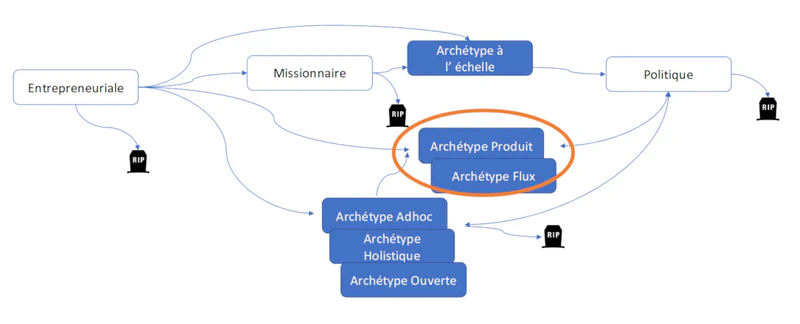
Example Problem: Who Am I? An Industry, an Artisan or an Innovator?
Can I remain a product archetype (market logic)? Should I reinvent myself (adhoc archetype) by drawing on my outstanding skills and keep a very strong identity? Or should I seek leverage, mass (company at scale archetype) even if it means losing my excellence?
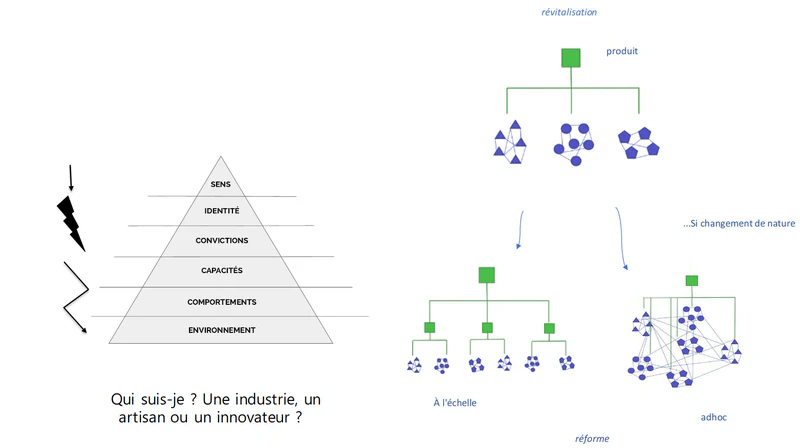
That’s the end of these examples. Good reflections for the future.
Slides, the Slide Show
More slides, but less explanations below. If this makes sense for you and for us, don’t hesitate to contact us to hold this meetup again.
[
Thank You
A big thank you to CFM for its welcome, its buffet, its terrace, its beers. Thanks to all the people present, for the smiles and conversations.
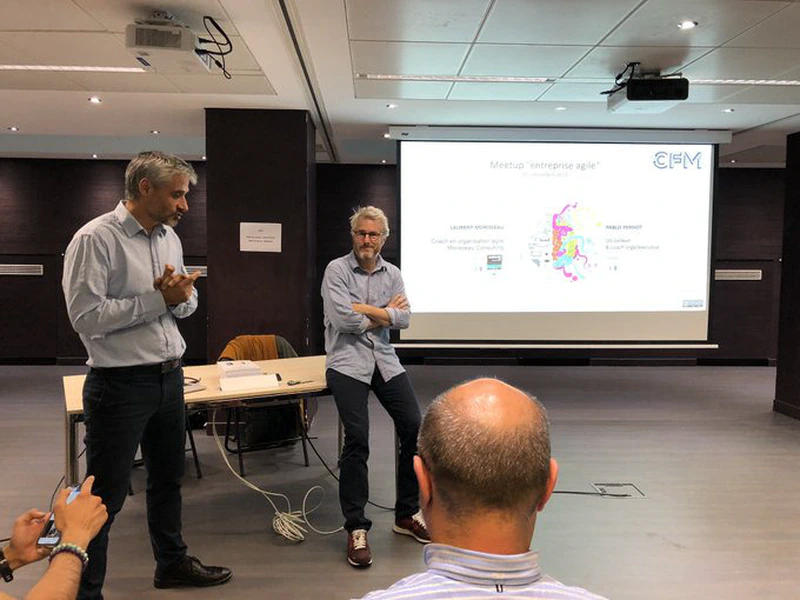
Sources
- The first part on complex organizations
- The second part on complex organizations
- Wikiversity on Mintzberg
- HRMag on Mintzberg, 2019
- Organizational forms according to Henry Mintzberg, Alain Dupuis, Richard Déry
- A model for the agile enterprise, by Laurent Morisseau
- Complex organizations, part 1
- Complex organizations, part 2
- Dilts pyramid and organization harmonization
- Slides from the 2019 meetup
- PDF file: Any resemblance… on the Dilts pyramid at BENEXT in 2019